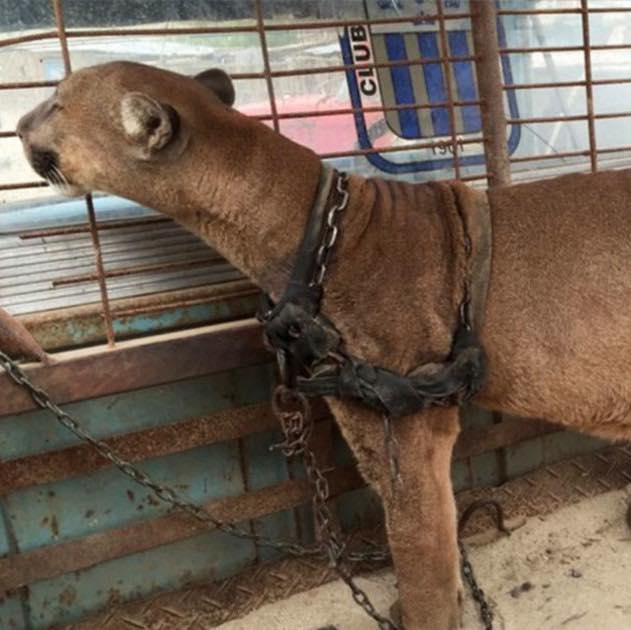For two long decades, a majestic puma named Mufasa lived in misery, confined to the cramped cargo bed of a rusted old pickup truck. This was not a temporary cage or a transportation method—it was his permanent home. Mufasa had been forced into a life of captivity and exploitation as the star attraction in a traveling circus in Peru, living every moment in chains so he could perform for the amusement of strangers.
Despite being a powerful wild animal meant to roam forests and mountains, Mufasa spent his life surrounded by noise, concrete, and metal. He was deprived of his natural instincts, denied the freedom to hunt, roam, or rest beneath the canopy of a forest. The fact that an animal as striking and intelligent as a puma was kept in such appalling conditions speaks volumes about how the entertainment industry can continue to exploit animals under the guise of spectacle and tradition.
Pumas, also known as mountain lions, have long been admired for their strength and grace. New settlers in the Americas once believed they were lionesses, and since then, they’ve held a certain mythical allure. Unfortunately, that fascination has created demand in circuses and roadside shows, where wild animals like Mufasa are seen as exotic curiosities instead of sentient beings.
When Mufasa wasn’t performing, he was chained and locked in the bed of a truck. For 20 years, this was the only life he knew—one of isolation, confinement, and daily stress. But in 2015, everything changed.
After years of monitoring and preparation, the non-profit organization Animal Defenders International stepped in. They had been working tirelessly to shut down the illegal and abusive Peruvian circus that had enslaved Mufasa for years. He was the last wild animal to be rescued from that circus, and when the chains were finally removed from his body, Mufasa’s life began anew.
He was old. He was tired. But he was free.
Though he could never be released into the wild after so many years in captivity, a special sanctuary was built just for him—designed to resemble the Peruvian forest he should have called home from the beginning. It wasn’t perfect, but it gave him something he’d never had: peace.
In a video captured shortly after his rescue, Mufasa steps onto soft earth, touches grass for the first time, and feels the sun as something other than a burden. His reaction is pure, silent wonder. It’s not loud or dramatic—just quiet, deep relief. A creature of the wild, rediscovering what it means to be alive.
Sadly, Mufasa’s newfound freedom was short-lived. He passed away in December 2015, only a few months after his rescue. Years of neglect had left his body frail, his organs failing, his health irreparably damaged. He died of kidney failure and other complications related to age and long-term captivity.
Though his time in freedom was brief, it mattered. Mufasa’s story isn’t just heartbreaking—it’s a wake-up call. It reminds us that animals are not props, they are not tools for profit, and they are not meant to live in chains. His final months, surrounded by forest sounds instead of circus noise, gave him a glimpse of the life he always deserved.
The real tragedy would’ve been if he had died in that truck bed, never knowing freedom at all. Instead, Mufasa left this world with dignity, touched by kindness, and finally—finally—at peace.
If you believe animals like Mufasa deserve better, share his story. Let it be a reminder that compassion must triumph over cruelty, and that every creature deserves to live free.
